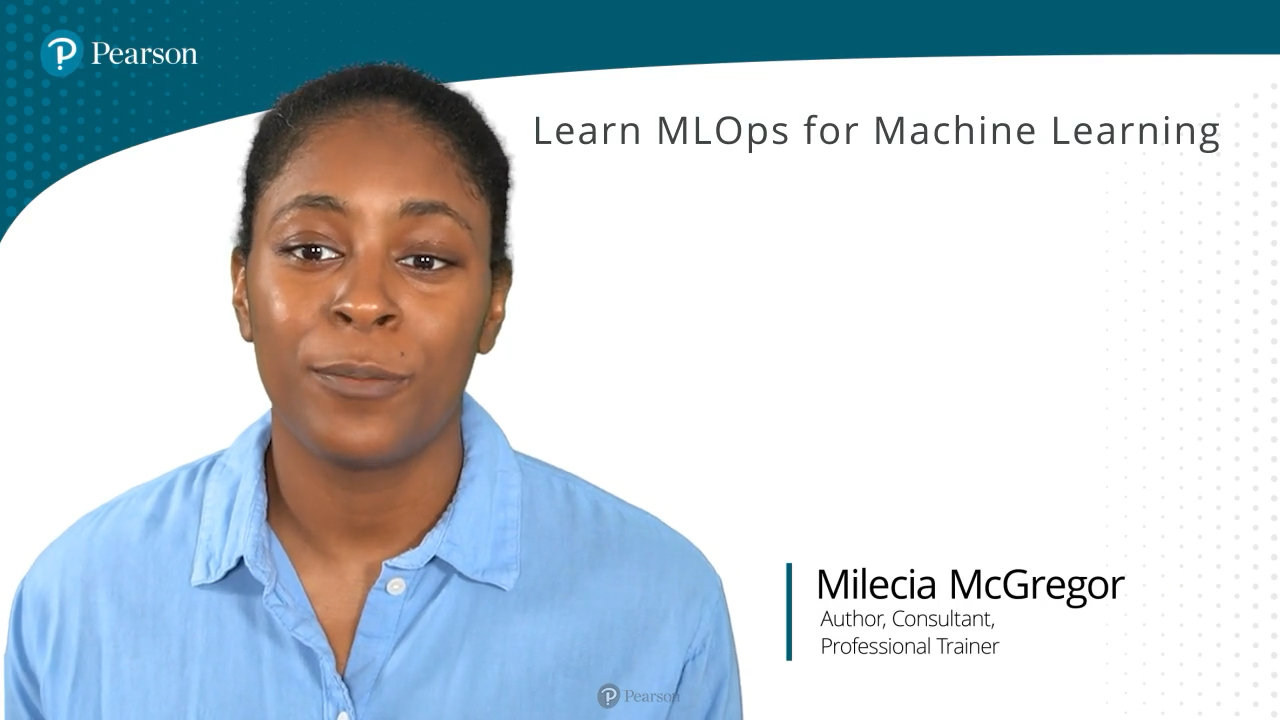DevOps Tools and Principles (Video Collection)
- By Milecia McGregor
- Published May 2, 2024 by Addison-Wesley Professional.

Online Video
- Your Price: $279.99
- List Price: $349.99
- About this video
Video accessible from your Account page after purchase.
Register your product to gain access to bonus material or receive a coupon.
Description
- Copyright 2024
- Edition: 1st
- Online Video
- ISBN-10: 0-13-535889-2
- ISBN-13: 978-0-13-535889-4
8+ Hours of Video Instruction
Overview:
This master class includes the following courses:
- Learn MLOps for Machine Learning
- Securing Your DevOps Pipelines
With both machine learning and DevOps at the forefront these days, Milecia McGregor helps engineers understand how to apply key DevOps principles to their machine learning projects in Learn MLOps for Machine Learning.
When teams are working with machine learning models, changing features, different data sets, new algorithms, and unique computing resources all influence a machine learning models performance. Tracking all of these items can be complicated. With tools such as DVC, MLFlow, and AWS, you can meet the challenge. Milecia McGregor demonstrates how to use MLOps tools to improve machine learning and automate some of the steps in the process.
In Securing Your DevOps Pipelines: DevSecOps Best Practices, Milecia covers how DevSecOps improves upon regular DevOps pipelines. She covers the tools and methodologies you can use to bring DevSecOps to your organization. By the end of the course, you will know how to build a DevSecOps pipeline and how to integrate different tools to handle the OWASP Top Ten, as well as compliance checks to stay up to date with regulations like HIPAA, PCI, and GDPR.
Prerequisites:
- Familiarity with building ML models in Python and managing data in AWS S3 buckets. Also, familiarity with Git and GitHub
About Pearson Video Training
Pearson publishes expert-led video tutorials covering a wide selection of technology topics designed to teach you the skills you need to succeed. These professional and personal technology videos feature world-leading author instructors published by your trusted technology brands: Addison-Wesley, Cisco Press, Pearson IT Certification, Sams, and Que. Topics include IT Certification, Network Security, Cisco Technology, Programming, Web Development, Mobile Development, and more. Learn more about Pearson Video training at http://www.informit.com/video.
Sample Content
Table of Contents
Learn MLOps for Machine Learning
Introduction
Lesson 1: Learning the MLOps Pipeline
1.1 Gather the data
1.2 Analyze the data
1.3 Prepare the data
1.4 Train a model
1.5 Evaluate the model
1.6 Validate the model
1.7 Deploy the model
1.8 Monitor the model
Lesson 2: Handling the Data
2.1 Determine what the data sources are
2.2 Create ETL pipelines to compile the data
2.3 Understand the data schema with respect to the model
2.4 Identify data that can be used for the model
2.5 Perform feature engineering
2.6 Version the data with DVC
2.7 Make multiple data sets
2.8 MLOps best practices for data
Lesson 3: Creating a Model
3.1 Use common Python libraries
3.2 Code versioning with Git
3.3 Perform hyperparameter tuning
3.4 Track experiments with MLFlow
3.5 Track experiments with DVC
3.6 Evaluate the models
Lesson 4: Working with Production Models
4.1 Decide the best deployment method
4.2 Test on pre-production environments
4.3 Deploy to production
4.4 Monitor the model for drift
4.5 Validate the pipeline flow
4.6 Automation points in MLOps
4.7 Set up redeploy pipeline
Summary
---
Securing Your DevOps Pipelines
Introduction
Lesson 1: Background on DevOps
1.1 Understand where DevOps came from
1.2 Learn how DevOps works
1.3 DevOps versus Waterfall
Lesson 2: Security in DevOps or DevSecOps
2.1 Show where security comes in
2.2 Learn how issues get to production
2.3 Learn the OWASP 10 top security risks
2.4 Understand how attackers gain unauthorized access to apps
2.5 Learn the basics of DevSecOps
2.6 Use DevSecOps to mitigate risks
Lesson 3: DevSecOps Tools
3.1 Learn about SAST
3.2 Use SAST tools
3.3 Learn about DAST
3.4 Use DAST tools
3.5 Learn about IAST
3.6 Use IAST tools
3.7 Learn about OAST
3.8 Use OAST tools
Lesson 4: Setting up a DevSecOps Pipeline
4.1 Set up the project
4.2 Set up CircleCI
4.3 Write the CircleCI config
4.4 Break down the pipeline steps
4.5 Add security to each step
Lesson 5: Final Security Checks
5.1 Learn how pen-testing works
5.2 Use Kali Linux tools
5.3 Use bug bounties
5.4 Perform compliance audits
Summary
More Information
